Presence Capital investor predicts the 2017 market for AR/VR

After nearly a year of investing in virtual reality and augmented reality startups, Amitt Mahajan is still bullish on the market. The cofounder of Presence Capital runs a VR seed fund with former HTC executive Phil Chen and startup veteran Paul Bragiel.
It’s a historic month for VR, with new platforms coming along like Google Daydream, Oculus Touch, and the Sony PlayStation VR. But Mahajan says that we are just at the beginning of a long cycle that will bring all sorts of changes to every industry. And Mahajan’s firm has already invested in 25 AR and VR startups.
Mahajan was at the ground floor of a different revolution. He was a co-creator of FarmVille, the Zynga game that helped Facebook take off in 2009. I caught up with Mahajan at the Oculus Connect event last week in San Jose, Calif. We talked about everything from his predictions for the VR market in 2017, the state of AR in the wake of Pokemon Go, and the prospects for Google Daydream View and the PlayStation VR.
Here’s an edited transcript of our interview.
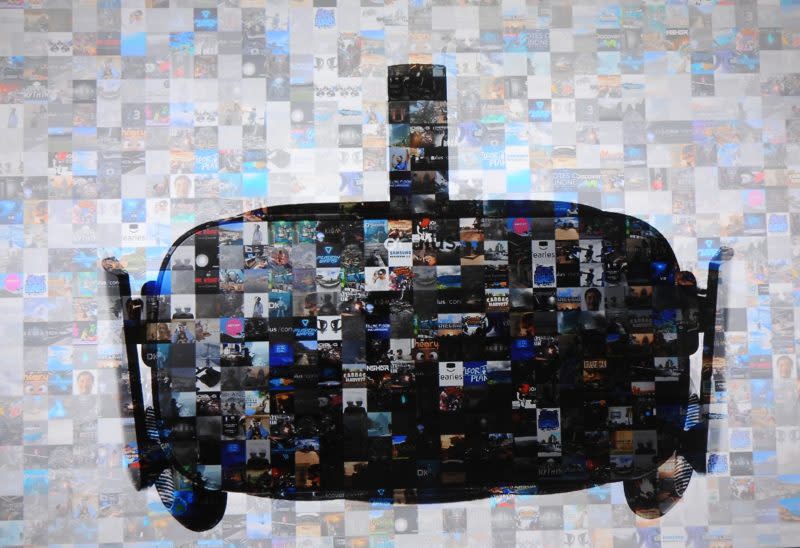
Above: Oculus Rift is more affordable than ever.
GamesBeat: I saw a release from Tim Merel at Digi-Capital. He said that in the third quarter, mostly mainstream VCs were moving into funding VR companies. Something like 65 percent of them were mainstream, and then 20 percent more were corporate VCs. The smaller groups were early stage VCs.
Mahajan: Let me push back on that a bit. Tim is doing a great job reporting on the industry, but I think it’s the wrong metric. Looking at dollars invested, it sounds big. Everyone understands money, right? But a couple things are driving that trend.
One is, we’ve done about 25 VR and AR investments. We’re one of the most active investors in the world when it comes to this space. There’s a CB Insights report that came out a few weeks back that put us in the top three. It’s good for the industry and good for everyone that we’re seeing more dollars put in, especially at the later stages. It’s good for our fund, because these are guys who are working with follow-on. We like investing with them. But if you look at pure numbers of investments and breadth of investments, ourselves, VR Fund, the seed stage funds are a lot more prolific.
By the time a company gets ready to do a bigger funding announcement, a series A announcement—we’re in about 25 deals, several of which are not public yet. When the funding announcements come out, you’ll see that even though we’re a small check, our goal is to take a company from just founders at an early stage and shepherd them to the A. We help them set up their valuation, figure out metrics, figure out where they need to be to get that follow-on financing. That’s the way our model works.
As a result, it’s not that there’s necessarily a bigger level of activity by corporate and so on. I just think that there are actual business cases and justification for writing larger checks into VR. Which is great. It’s what we expected to happen. This validates our model.
GamesBeat: But it doesn’t mean the early stage folks are dropping out.
Mahajan: Exactly. If anything, some of our earlier investments are now starting to come to maturity. The market is only just getting started, but it’s maturing.
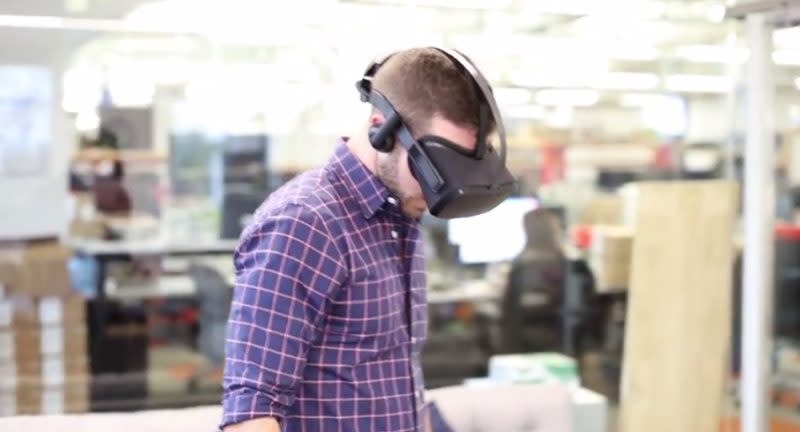
Above: Oculus wireless standalone Santa Cruz prototype.
Image Credit: Oculus
GamesBeat: The presence of the mainstream and corporate folks seems to suggest—they wouldn’t be there if this were just a flash in the pan.
Mahajan: A couple of things drive that forward. A lot of the core technology, especially being developed for AR on the computer vision side, has applicability to multiple domains. If you have a great team doing computer vision for hands or something else, a lot of the corporate investors see that as the future of computing in general. Not just something that can be used to power a VR headset.
You see Intel, especially, being very active in this area. You see folks like Snapchat starting to acquire companies doing computer vision. You’re seeing more activity because people view it as a core technology. Machine perception is a core technology that will power the next wave of computing. If you’re not investing right now, three or four years down the line when consumer AR becomes mainstream you’ll be too far behind on the software side.
It’s a shift from what we’ve seen in technology in general. The large companies are not asleep at the wheel. They realize that disruption does occur and will occur. They’re taking steps to counteract it. A lot of the investments you see are defensive in nature. Folks are preparing for the future. They believe these technologies, even if they’re not there yet, will be there someday. They need to make a play now, because that’s how they’ll be ready for the future.
GamesBeat: Did you notice a shift toward AR in the wake of Pokemon Go?
Mahajan: No. That was a bit of a red herring. Pokemon Go is a really good example of location-based gaming. The thing it did do is it made AR a household word. Everyone started paying attention to it. But for folks who are deep in the industry, Pokemon Go is not a great example of where AR is.
You could say the same thing about Snapchat. It’s just a wedge. What Snapchat’s doing with Spectacles is a really interesting example of a company that—it looks like a toy on the surface, just like Pokemon Go. But some of the technology being developed and being socialized is what we need in order to build the next version of AR. Pokemon Go is a stepping stone from that standpoint.
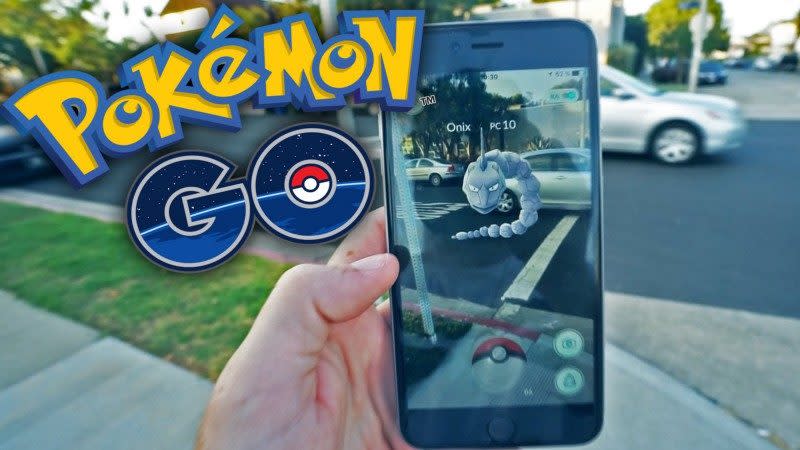
Above: Pokemon Go is leading the conversation about VR/AR.
GamesBeat: What are you excited about at the moment in VR?
Mahajan: There are two areas in particular. One is productivity. VR as a tool for creators and producers to do more, or work smarter. BigScreen is one that’s really popular. They allow collaboration in VR. You bring your screen and your computer into VR and compare coding and so on. Soundstage is interesting. They’re taking a music production room and allowing people to set up a studio without having to buy all this expensive, heavy, bulky equipment you normally see in a music studio. But you have all the same capability. You can set it up around yourself, however you want to customize it, and store all that in the cloud. Wherever you go, you have your setup the way you want it.
We’re a bit of a ways away from everyone using VR as a desk replacement, if only because the resolution on the headsets isn’t there yet. We probably need a couple of iterations before we see that. We’ll get there eventually. Productivity is still very interesting.
The other thing we’re interested in is training. One company that just showed up on our radar is helping medical device companies train their salespeople, demonstrating how to use their machinery through actual modules. You have this bulky expensive equipment that’s really hard to transport, but you want to demo it for a customer. VR makes that really easy.
We feel that, in the B-to-B context, there’s a huge opportunity to help companies train each other. StriVR is another example that’s doing this. They’re more in sports. They’re starting to expand. But VR training is a perfect use case for VR. Because it’s being sold to businesses, the cost of the hardware and the bulkiness of the hardware are non-issues. The business model makes it a case where we’ll see a lot of big companies very quickly. Corporations can afford to pay for something that makes their operations more effective.
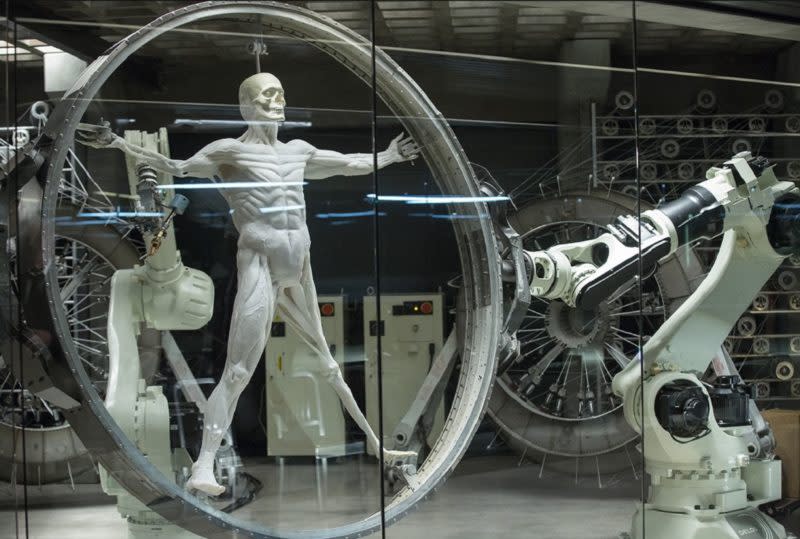
Above: What the guests don’t see behind the scenes at Westworld.
Image Credit: HBO
GamesBeat: Did you get a chance to see Westworld on TV? Sometimes it seems like science fiction leads the way. They look at VR and argue that it’s the poor man’s version of virtual travel. Everyone has it in their homes in the future, so if you’re really rich, you go this place that’s some kind of combination of physical and virtual.
Mahajan: I can totally see that. People are using it for therapy now, as a way of taking people out of the real world. Maybe they’re in a hospital and it’s depressing. A company called Applied VR is doing this for chemotherapy. VR can be very therapeutic if it’s used in the right way.
You can make the argument that it’s a way of—urges you can’t act on in the real world, VR provides an escape for that too. It’s what violent video games are for a lot of people.
GamesBeat: I look back at things like Snow Crash or Minority Report and see Silicon Valley tech startups coming along later to adopt whatever vision they have.
Mahajan: Neal Stephenson has done a bang-up job of being prescient about a lot of things. Let me throw out a counterpoint, though. A lot of times those movies lead us down the wrong technological path. Everyone saw Back to the Future and wondered when we’d get hoverboards and so on.
GamesBeat: Self-lacing shoes, like Nike just did.
Mahajan: Right. They’re cool to see. It’s a cool vision of the future. But because we’ve been trained to think technology should be a certain way because of a movie we saw, we end up following that path instead of realizing a completely orthogonal solution.
Every sci-fi movie, even up until now, has screens in it. People look at monitors. But in a world with VR devices, screens shouldn’t exist. They’re outmoded. But watch any sci-fi movie, you wouldn’t realize that. Everyone goes around optimizing for a screen when we really want to build the Magic Leap device. Even the Minority Report device is still a screen. The reality is we won’t have terminals. We shouldn’t have to go to a physical location to do what we need to do. We shouldn’t be beholden to something that’s essentially just a light-emitting device.
If we build that into our vision, we can create those wherever we want. I can have a tablet in front of me on a table. You shouldn’t have to have a computer in front of you. You could be typing on the air. We build these ideas because that’s where we get our inspiration from. But truly inventive companies, truly inventive thinkers, will think outside and ahead of what pop culture has told us the future will be like.
Autonomous vehicles are another big example. I don’t think we realize how that’s going to transform society. AR will be the same way.
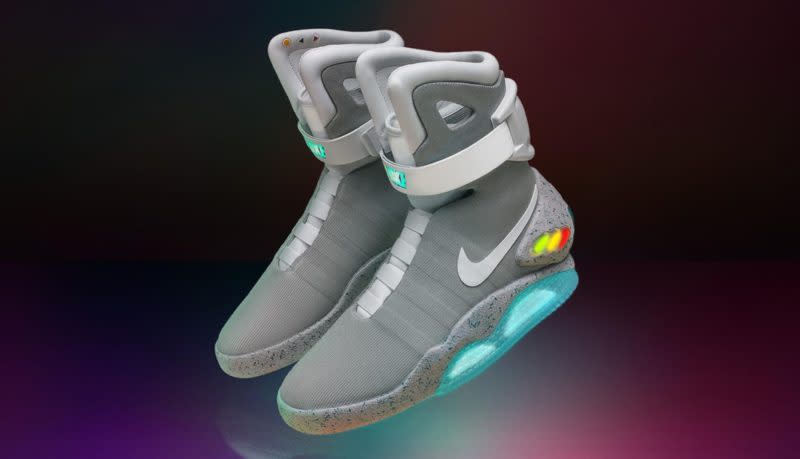
Above: Nike’s Mag shoes are based on the self-lacing pair in Back to the Future II.
Image Credit: Nike
GamesBeat: What’s the most interesting inspiration that you’ve seen?
Mahajan: Ready Player One is cool, because it was a unifying picture. For me, though—as a venture capitalist, as an investor, you’re trying to seek out truth, essentially. You’re seeking out the basic building blocks, the facts, and what you can infer from those.
The person who’s the best at this — it’s almost a cliché at this point – is Elon Musk. Both of his companies, he started from first principles and built on top of those. I look at how he determined how SpaceX was going to work. How we get to Mars. How we get away from relying on oil. I think about how that applies to VR. In a world in which we all have portable VR devices or perfect AR devices – where an AR object is indistinguishable from a real one – what changes happen in the world? What new applications are enabled? How does human behavior change?
When you go through that thought process – here’s the fact of where we are, here’s what we think is going to happen because of that – that’s how we determine where to invest. Our inspiration is anyone who’s managed to do it before us successfully. There was a great article that came out today from Arjun Sethi at Social Capital. He talks about how social networks are evolving from being networks into hives. Slack is a good example of this. Those guys are super inspiring.
I’m as susceptible as anyone else to Star Wars and the Matrix and so on–
GamesBeat: It’s like a world without screens is no fun.
Mahajan: There’s this video called Hyperreality. You should check it out. It goes the other way. In a world without screens, where anything can be a screen, it’s actually overwhelming. You look around and this entire wall is an advertisement. This chair is branded. The entire world becomes a pop-up ad.
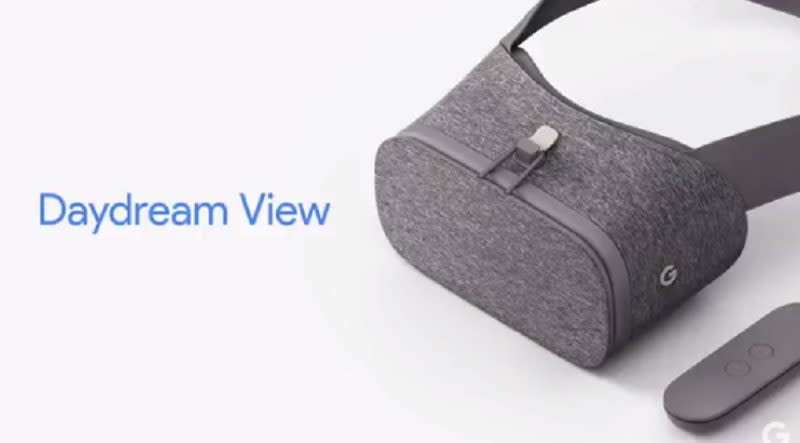
Above: Google Daydream View headset from Google.
Image Credit: Google
GamesBeat: What would you predict about 2017 in the VR market?
Mahajan: Let’s start with facts. The Daydream came out just now. Google is the only manufacturer of a Daydream phone. Daydream’s specs requires OLED screens. OLED has very poor yield rates and is hard to manufacture. Therefore, it’ll be a while before any additional Daydream phones come on the market.
HTC is manufacturing Google’s Daydream phones. They’re the Foxconn for Google. If HTC is manufacturing Google’s Pixel phone, that probably means they have the technology to manufacture their own HTC-branded phone as well. You can predict that HTC will probably come out with a Daydream-enabled phone.
The iPhone 7 does not have an OLED screen. OLED is required to provide the low-latency screen you need to do VR. Until we see an iPhone with a low-latency screen, it’s unlikely that Apple will release a VR device. They may release the VR device alongside the version of the iPhone that eventually has an OLED screen.
So what does this all mean? For the mobile VR market it means that next year Daydream will become a real force in mobile VR. Maybe later next year, once more phones are announced for the platform. Any increases or improvements in OLED technology, especially the manufacturing yield, will accelerate the VR market.
I predict next year we’ll see more people use mobile VR. The primary use cases will be watching existing media. Basically Hulu, Netflix, HBO, Google Play. If Apple comes into VR, the earliest would be next year. It’s already pretty late. I’ll be surprised if it’s next year, but they may have to. The first version of their VR device, they probably won’t be pushing more than the media consumption aspect of it, rather than the games aspect.
On the high-end VR side, I expect that the first major market for high-end VR is going to be China. VR in China is being adopted by theme parks, malls, retail locations. If you’re being adopted by a business rather than a consumer, the cost of the hardware and the bulkiness doesn’t matter as much. You can pay back the cost of the hardware. They’re already used to internet cafes and pay-per-use services. China is a perfect market for high-end VR, PC-based VR, to thrive in an arcade type of environment. Vive will be big there. Oculus isn’t there as much yet, but they’ll try.
We’ll see version two of all this stuff. On the technology side we’ll see positional tracking in mobile VR. A few companies are working on that. We’ll see some better forms of input.
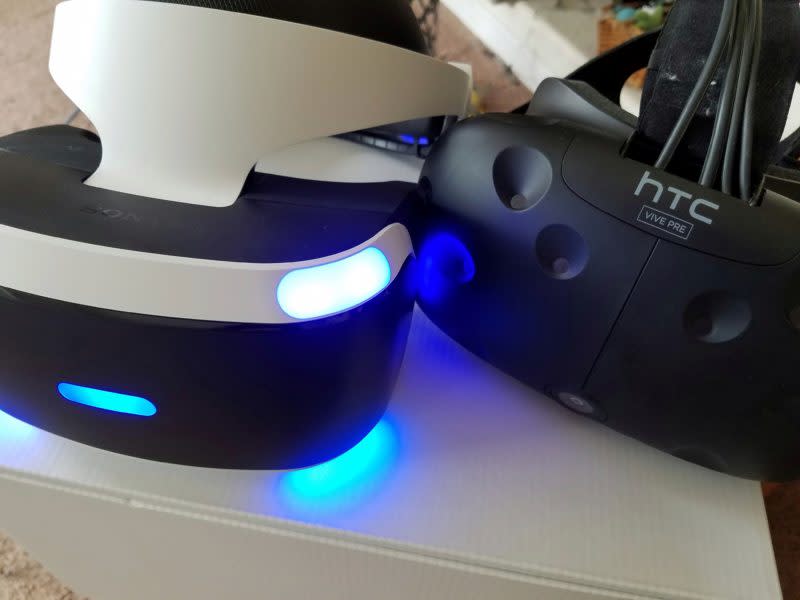
Above: The PSVR sitting alongside an HTC Vive.
Image Credit: Jeffrey Grubb/GamesBeat
GamesBeat: Does it look like Sony PlayStation VR will be successful?
Mahajan: I think so. They’re sold out, after all. They’ve done a good job with their content. For them it’s a console launch. Microsoft will probably announce something as well. They’ll have to. If you want my prediction, the real reason Microsoft is launching their new console is so they have enough horsepower for a VR headset. If they don’t build it internally, maybe they’ll partner. They have a pretty close relationship with Facebook.
My last thing, Snapchat’s Spectacles will be a phenomenal success. They have stereo cameras, so we’ll start to see more 3D imagery and 3D pictures, that kind of thing. Spectacles is a Trojan horse for an AR device in the long run. Right now it’s capture only, but eventually it’ll become—there’s this episode of Black Mirror on Netflix where everyone has contact lenses that record everything they see and play it back. Spectacles is version one of that.


